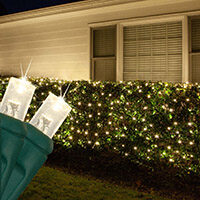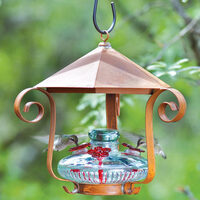-
The V Pattern
Pressure Points
The pinnacle point faces twice the force.
The V Pattern
It may seem basic but there is one very important point many miss until the last minute. A "V" pattern has only three points, which means the pinnacle point bears the full force of the string from two angles. The two endpoints face only half the pressure. If you think a "V" pattern is your best option, make sure your pinnacle point is well anchored to withstand the constant pull of the string tension from both sides.
The "V" pattern can be used almost anywhere. While both sides of the "V" don’t have to be perfectly equal, aiming for some symmetry is recommended if you have spaces like large squares or rectangles to span.
If you are considering a "V" pattern within trees or in an outdoor space with oblong or non-symmetrical ends, your pattern will likely look better by actually allotting different lengths for each side of the "V" so it fills the space more naturally.
The X Pattern
Usually this pattern is achieved using two different string light strands hung at 90 or 45 degrees from one another. The resulting patterns create either curved squares or curved triangle spaces between the string lights. If you have a square or rectangular patio, deck, yard or rooftop terrace, this technique can look stunning.
This pattern requires four endpoints. In some cases you may not have four points that can accommodate this pattern, which is why many people opt for adding tall posts or poles that are inserted into the ground or tethered to other structures (like deck railing or fencing) that provide the extra hanging points required.
The curved triangle pattern in particular is popular because the contours run at 45 degree angles. This simple angle change in conjunction with a nice swag is a longstanding design technique that contrasts the “squareness” of the space. A 90 degree X pattern cannot accomplish this.
-
The X Pattern
Square Contrast
The curved triangle version of the X pattern is very popular because it provides greater contrast.
Zig-Zag W Pattern
Playful and fun, the zig-zag pattern is an extension of the "V" pattern. It can be accomplished with one long string light but the simplest form of the pattern requires five hanging points. Think "W" instead of "V" where three points carry a disproportionate amount of line tension. A 100 ft. string light could be hung and angled every 20 ft. If your outdoor space is smaller and can accommodate five 20 ft. swags, this might be the ideal.
However, for many outdoor spaces like large backyards, terraces or decks, it may not be enough and you’ll have to consider additional string lighting to make your zig-zag come to life at the size you need. Similar to the patterns above, more hanging points means more structures to hang lights from. If you are "structure challenged" this pattern may be too difficult to achieve without adding multiple posts or poles from which to hang your points.
-
The W Pattern
Zig-Zag Swagger
Fabulous but challenging, this pattern needs 5 hanging points.
While this pattern can look absolutely fabulous because of the added perspective it showcases, it is also more challenging. It is a great choice if you really want to light up your outdoor space.
-
The Square
Scalloping
A good curve in your swag will make your border more pronounced and dramatic.
The Scalloped Square
A unique border design technique, the scalloped square design utilizes string lights around the perimeter of a square where the swag of the string is often more pronounced and dramatic. This technique is common on decking or outdoor covered locations where it is easier to hang lights at the perimeter of the space rather than through the middle of the space due to obstructions like columns, fans, or foliage.
Because this technique adheres to borders, keeping your swags consistent all the way around will make this pattern look its best due to the contrast. A good curve in your swag will offset the fact that your lights are hung in a simple square. Also consider that square patio light designs pull in two directions at every point so make sure you point are anchored well.
The Horizon Point
This lighting design technique can be seen at events, restaurants, hotels and in cafe bistro street lighting, While it tends to be professional installation, it can be applied to residential outdoor spaces very easily. However, it requires more hanging points and planning. Whether your project is for your home, business or an event, consider that this technique involves advanced design knowledge of perspective, horizon lines and elements of hub and spoke design. For many DIY’ers or those who are a little more design savvy, this technique can be easily accomplished. If you’re not sure about how to do this, consider contacting a professional designer with event or space design experience.
While some horizon point designs all meet at a single point, this is not always required. In many cases, your horizon line zone may span several feet, but the key is that it is always narrower than where your string lights fan out to. If you plan to implement a design like this where you require multiple light strings, consider using LED bulbs to make your electric requirements much simpler. If you prefer incandescent bulbs and you have more string lights being used than your plug circuits can handle, you’ll need to add extra capacity. This may require hiring an electrician.
For smaller designs, this pattern may use as few as four or five string lights. Larger designs can span several dozen string lights depending on how dense the light canopy is intended to be. If you are considering this design approach, also consider that this technique requires very consistent swags so that it looks good from all angles. The height of your hanging points and the distance between each end point should be identical so the curves and angles of each line are consistent no matter where you stand.
-
The Horizon Point
Consistent Swag
Make sure your height, distance and swag are very consistent so your design looks good from all angles!
-
The Tent Point
Hub & Spoke
Make sure the center beam is strong enough to hold numerous light strings.
The Tent Point
Please note this string light design may require professional assistance as it requires a central post, beam or other structure strong enough to hold numerous string lights. This technique uses an elevated hub and spoke design where you are creating a "curved roof" of lights from a central point that is higher than all its endpoints. The effect can look like a vaulted
ceiling of string lights and it is highly popular for events. The swags in this design can be very dramatic since the curvature fans out to points but often includes notable elevation from one point to another. Similar to the horizon point design, this technique may require a number of individual string light strands in order to make the space look balanced.



















